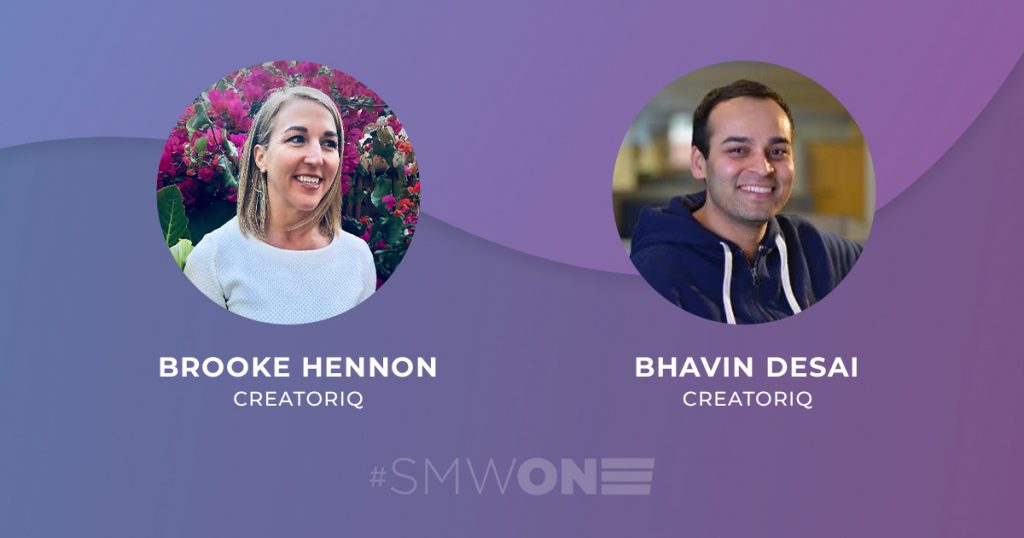In an industry where there are many points of friction for influencer marketers and algorithms, artificial intelligence, and machine learning solutions seem to penetrate every sector and business category, how can businesses establish strategies to scale ROI? How can they scale the identification of their creator partners? How can they increase confidence in content?
During #SMWONE, CreatorIQ’s Head of Customer Success, Brooke Hennon joined by Bhavin Desai, VP of Product Strategy, addressed these questions breaking down how the platform is using advanced data science to create intuitive influencer marketing solutions. Through a holistic, outcomes-based recommendation engine, CreatorIQ is combining multiple data science models spanning influencer identification, content attribution prediction, and audience targeting.
Here are the primary insights and takeaways:
- Any person with a social presence can be an influencer
- To scale the reach and frequency of your campaigns, lean on lookalike audience-powered media
- To scale the reach and frequency of your campaigns, lean on lookalike audience-powered media
Finding the best creators for your campaigns
A common paint point amongst marketers if finding the right influencers to partner with. The vast majority put a significant amount of time against searching for more influencers that match the aspirational collaborations or already in-flight relationships and desire efficiency. According to Hennon and Desai, right now this process is an art form without guidance and data science is a key solution to helping it become less subjective and more efficient so desired results can be achieved.
“We’re leaving millions of data points across performance, creator approvals, brand affinity, and industry alignment to build a recommendation engine trained to identify the best creators for any campaign.” By constantly evaluating performance data, additional creators can be added on-demand to the engineer based on current high-performing creators. This system can also be leveraged by lookalike creators but specific to a certain demographic (e.g. I want 10 more influencers like this but based in London for this next campaign). Beyond location, gender and interests are other elements that can be used to help identify best fit creators. This can all be combined with the core campaign and brand goals to help identify the best fit creators for any campaign.
“As influencer marketing grows, it needs to scale to go to toe-to-toe with other marketing methods. We have to do it more efficiently,” said Hennon. This starts with finding and collaborating with the right influencers with strong performing content that aligns with your brand.
Increase content confidence with content attribute prediction
Once you’ve honed your identification strategy, the second step focuses on scaling content performance. When thinking of content direction to use to brief influencers, marketers often use little science and, again, rely on subjectivity much like when they set out to look for influencers at the onset of a campaign. To address this, CreatorIQ leverages several approaches to identify and drive the delivery of high-performing content.
“What resonates on TikTok is very different from what resonates on Facebook,” Desai claimed. To remove some of the guesswork, the company is leaning into visual insights to build data science models focused on the identification and recommendation of high-performing content. This is in partnership with some of the leading virtual recognition engines like Google Vision to analyze tens of millions of pieces of content. From this information, custom models are built that can correlate to specific visual and performance attributes detected within the content and provide recommendations around what has the highest likelihood to perform well. This is particularly informative when devising paid campaigns.
A key takeaway: content attribution prediction is not only useful in driving content confidence in the present but can be a useful mechanism to future-proofing briefs in additional campaigns. Frequently influencer marketers lack the bandwidth to build data-driven briefs and this is a solution that takes the headache out of this equation.
“Another key outcome of the visual insights model is the ability to leverage data from the content to not just recommendation campaign content but also deliver refined creator requirements to drive the creation of high-performing content,” explained Desai.
Scaling audience targeting and reach
Marketers want to maximize the reach of the influencers’ best performing content — beyond the fans and followers of partner influencers There are several variables to consider in the influencer space from content to people to different audiences and knowing which levers to pull is a recurring problem. How can there be a more elegant and effective way to amplify content?
CreatorIQ is addressing this question heads on with a model that leverages influencer data like demographics, organic and paid performance to drive the creation of lookalike audience seed segments that are used as inputs to social platform audience targeting
“We have seen significant improvements in conversion data when compared to standalone audience targeting available within the platforms directly, for example, Facebook’s Ads Manager,” Desai explained. What this boils down to is brands having the ability to take a subset of influencers correlated with high performance within a designated campaign and then identify additional lookalike influencers based on those performing well. These can be leveraged to create a “seed segment” that drives lookalike audience targeting. The immediate result to note: improvements on ad spend.
“Any person with a social presence can be an influencer,” said Hennon closing out the session. Build your army of brand ambassadors by recruiting employees or super fans of your product.
Join 100,000+ fellow marketers who advance their skills and knowledge by subscribing to our weekly newsletter.
